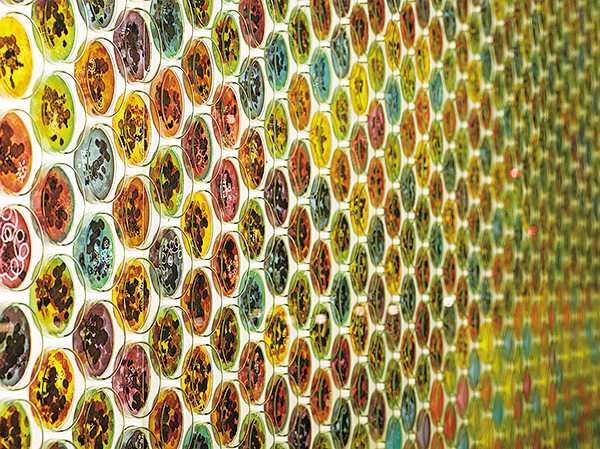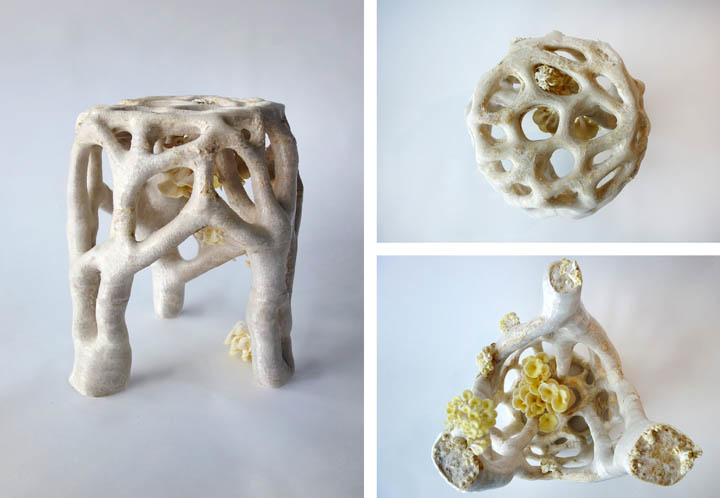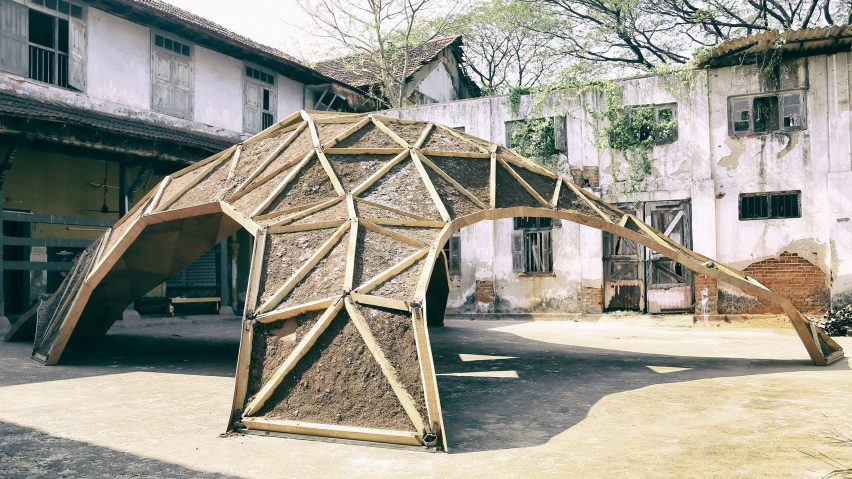What is a Bio-design?
Bio-design is a field that is incredibly relevant to all designers now, it entails using organic materials, getting inspiration from nature, creating a symbiotic link between live organisms and design, and enabling nature to influence the result. Using the natural world’s intelligence and adaptability, we can construct long-lasting creations that may be self-repairing. This intersection between biology and design is a budding concept now being applied in various facets of design – in fashion, products, furniture, etc.
A brilliant example of furniture manufacturing would be growing a chair from mycelium, a mushroom fungus that is surprisingly robust for furniture. This fascinating element also has a role to play within architecture. The concept and application of Biodesign is employed by designers to mimic natural processes. In the case of buildings, designers and architects are now building passive ventilators mimicking the role of termite mounds for better air ventilation. One example from Mumbai for that would be The Hive, This office building is designed to be energy-efficient and environmentally conscious. It features a biomimetic facade inspired by termite mounds, which helps regulate temperature and reduce energy consumption for cooling.

Biodesign Everywhere, Nature finds its way in the simplest of Products
Designers around the world are increasingly cooperating with nature to create innovative daily products using organic materials and sustainable manufacturing processes. Despite their cleverness, broad acceptance of these inventions remains difficult. For example, in France, cups and plates made largely of algae are being developed, but severe food product requirements are preventing them from entering the market. Another example is designer Natsai Audrey Chieza, who pioneered a dyeing technique that uses bacteria and eco-friendly materials, breaking away from the traditional chemical-heavy procedures used in the textile business.

Bio-design in Architecture, Role of Nature in Design
Bio-design in architecture provides practical solutions while creating a harmonious relationship with our natural environment. This includes using sustainable building materials and designing symbiotic features that benefit both humans and the surrounding environment. Wood is an important material in Biodesign due to its sustainability, adaptability, and biodegradability. Its applications range from building to medical equipment, with ongoing research and design efforts concentrating on the innovative incorporation of wood components into various products while addressing ecological and environmental concerns. In 2017, A collaboration between Indian and Italian architects resulted in the construction of a pavilion in southwest India using mushroom mycelium, showcasing its potential for temporary event venues. Asif Rahman from Beetles 3.3 in India and Giambattista Arredia along with Mohamad Yassin from Yassin Arredia Design in Italy joined forces to create the Shell Mycelium installation in Fort Kochi, Kerala. Their goal was to highlight mycelium, derived from mushroom root networks, as an eco-friendly alternative construction material ideal for temporary structures, emphasising its sustainable properties.
What is Biomimicry?
We have long been inspired by nature, various steps of the way our aesthetics and the world around us have evolved with the natural world around us. The popularity of building projects with forms inspired by nature has grown, yet design with the intricacy of natural structures could only occur once technology caught up. A stunning example of merging nature with architecture and technology or Biomimicry would be the Shi Ling Bridge’s design which is based on optimal curvilinear geometry, combining rigour with corrugation for structural strength. Incorporating holes lightens the design, reducing material use and carbon footprint. This method produces a bridge that appears flowing and fits smoothly into its surroundings. In addition, the bridge’s natural design features inclinations and bends, which add to its organic attractiveness. Closer to home, we have many structures that resemble that of elements of the natural world. There is the Lotus Temple, Delhi, inspired by the design of a lotus flower, this renowned monument features white marble petals. The design represents the harmony of nature and spirituality. The Infosys building in Pune is designed to look like a big leaf, with its curving and green-roofed structure blending in with the surrounding terrain.

What is Bofabrication?
Another interesting concept that exists within the realm of Biodesign is Biofabrication, it is the use of biological organisms to make materials and buildings, a notion that extends into architecture by using bacteria to grow materials or incorporating plants and animals into construction procedures. These procedures are not only sustainable, but they also reveal unique aesthetic and practical possibilities.
This technique allows for the development of materials with unique qualities such as self-healing capacities, sensitivity to environmental changes, and the ability to trap and store carbon dioxide, thereby reinforcing efforts to combat climate change.
Current State of Affairs
Now we are seeing designers working in Biodesign and Scientists merging to create something unique with Biodesign as well. A conference on Biofabricate is bringing together designers from big brands such as Microsoft and Nike to work with bioengineering and biologists. Paola Antonelli, MoMA’s curator of architecture and design, was essential in popularizing Biodesign by curating the pioneering exhibition “Design and the Elastic Mind” in 2008, which was the first major museum display dedicated to the subject.

The future of design is bright, with opportunities for sustainable innovation, environmentally friendly solutions, and harmonious interaction with nature in a variety of fields. In the context of our country, this evolution could profoundly impact India’s design landscape, fostering eco-friendly structures, products, and other innovations that harmonize with the country’s diverse ecosystems while promoting innovation in construction methods and materials.
References:
- https://www.fastcompany.com/3067449/a-guide-to-the-134-billion-biodesign-industry
- https://www.core77.com/posts/106366/Exploring-Bio-Design
- https://medium.com/design-council/what-is-biodesign-combining-nature-and-design-c5ff5766f864#:~:text=Biodesign%20can%20mean%20using%20organic,in%20shaping%20a%20final%20product.
- https://www.re-thinkingthefuture.com/architectural-styles/a5698-an-introduction-to-biodesign-architecture/
- https://rb-architectes.com/en/biotech-in-architecture-exploring-the-intersection-of-biology-and-construction-reid-brewin-architects/





